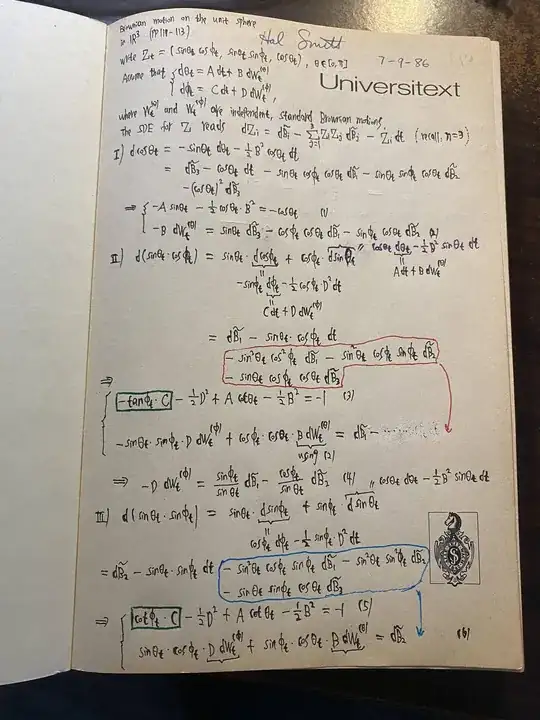The generator of Brownian motion on $S^2$ (with the round metric) is $\frac12\Delta$, where
$\Delta$ is the Laplacian on $S^2$, in spherical coordinates
$$\Delta = \frac{1}{\sin\theta}\partial_{\theta}(\sin\theta\cdot\partial_{\theta})+\frac{1}{\sin^2\theta}\partial_{\varphi}^2.$$
Let
$$ X_t=\sin\theta_t\cos\varphi_t,\\
Y_t=\sin\theta_t\sin\varphi_t,\\
Z_t=\cos\theta_t.$$
Now you suggest that if $B_t^{(i)}$, $i=1,2$ are two independent Brownian motions, then
$$ d\theta_t = dB_t^{(1)},\\
d\varphi_t = dB_t^{(2)},\tag1$$
defines a Brownian motion on $S^2$. We have
$$dZ_t=d\cos\theta_t=-\sin\theta_t\cdot dB_t^{(1)}-\frac12\cos\theta_t\cdot dt.$$
But since $\Delta\cos(\theta)=-2\cos\theta$, we have
$$d\cos\theta_t-\frac12\Delta\cos\theta_t=-\frac{3}{2}\cos\theta_t\cdot dt-\sin\theta_t\cdot dB_t^{(1)},$$
Thus $\cos\theta_t-\int_0^t\frac12\Delta\cos\theta_sds$ is not a local martingale. Therefore $\frac12\Delta$ is not the generator of your process (1), and therefore (1) does not define a Brownian motion on $S^2$.
There are many different ways to construct Brownian motion on the sphere. One of them works in Stratonovich form and reads
$$ d\mathbf{X}_t = \mathbf{X}_t\otimes d\mathbf{B}_t, \tag2$$
where $\otimes$ denotes a Stratonovich cross product and $\mathbf{B}_t$ is a 3d Brownian motion. In other words,
$$ dX_t = Y_t\circ dB^{(3)}_t - Z_t\circ dB^{(2)}_t,\\
dY_t = Z_t\circ dB^{(1)}_t - X_t\circ dB^{(3)}_t, \\
dZ_t = X_t\circ dB^{(2)}_t - Y_t\circ dB^{(1)}_t.$$
First of all we can check that by the Stratonovich chain rule
$$ d(X_t^2+Y_t^2+Z_t^2) = 2(X_t\circ dX_t+Y_t\circ dY_t+Z_t\circ dZ_t) = ... = 0,$$
hence $(X_t,Y_t,Z_t)$ is on $S^2$ for all $t\geq 0$ iff $(X_0,Y_0,Z_0)$ is on $S^2$. Then by the Stratonovich chain rule we obtain
$$ d\mathbf{X}_t = \frac{\partial \mathbf{x}}{\partial\theta}\circ d\theta_t + \frac{\partial \mathbf{x}}{\partial\varphi}\circ d\varphi_t,$$
By expanding everything and matching with the expressions above, we can solve for $d\theta_t$ and $d\varphi_t$ in terms of the Brownian motions:
\begin{align}
d\theta_t&=\sin\varphi_t\circ dB_t^{(1)}-\cos\varphi_t\circ dB_t^{(2)},\\
d\varphi_t&=\cot\theta_t\left(\cos\varphi_t\circ dB_t^{(1)}+\sin\varphi_t\circ dB_t^{(2)}\right)-dB_t^{(3)}.
\end{align}
We get this back into Itô form (please check), which leads to a drift term in $\theta_t$
\begin{align}
d\theta_t&=\frac12\cot\theta_t dt+\sin\varphi_t dB_t^{(1)}-\cos\varphi_t dB_t^{(2)},\\
d\varphi_t&=\cot\theta_t\left(\cos\varphi_t dB_t^{(1)}+\sin\varphi_t dB_t^{(2)}\right)-dB_t^{(3)}.
\end{align}
So now take a $C^2$ function $f(\theta_t,\varphi_t)$ and use Itô's lemma to check that
$$df(\theta_t,\varphi_t) = \frac12\Delta f(\theta_t,\varphi_t) dt + ... dB_t^{(1)}+ ... dB_t^{(2)}+ ... dB_t^{(3)}$$
(only the $dt$ term has to be calculated). This shows that the generator of the process (2) is indeed $\frac12\Delta$.
Addendum: By setting
\begin{align}
dB_t^{\theta}&=\sin\varphi_tdB^{(1)}_t-\cos\varphi_tdB^{(2)}_t,\\
dB^{\phi}_t&=\cos\theta_t(\cos\varphi_tdB^{(1)}_t+\sin\varphi_tdB^{(2)}_t)-\sin\theta_tdB^{(3)}_t
\end{align}
and checking that these are two independent Brownian motions, one can rewrite the process as
\begin{align}
d\theta_t&=\frac12\cot\theta_t dt+dB_t^{\theta},\\
d\varphi_t&=\frac{1}{\sin\theta_t}dB^{\phi}_t.
\end{align}
There is a third Brownian motion $dB^{N}_t=\mathbf{X}_t\cdot d\mathbf{B}_t$ that is normal to the sphere and therefore gets cancelled out.

